|
With a final thrust, Terry Keller (above, and again here) leans forward and takes the drop into the fast right-hand wall, rapidly accelerating as his board approaches a challenging 90-degree bowl turn. The talented goofyfoot squats low over his board, hands throwing shadows across the dozens of tracks left on the wall by previous rides and riders. The sharp turn snaps him into a new line, the speed whipping him ahead until he exits the ramp at the end of the long wall.
He circles back and into position for another ride. Although he’s a beginning surfer at the beach, this board has wheels under it, and this steep right-hand wall borders the asphalt playground of an area elementary school. The year is 1964. Keller is 11 years old, one of dozens of Pacific Palisades kids pushing the limits of the newly invented sport of skateboarding.
A budding photographer, I took a break from skateboarding to climb the playground backstop and take a picture of my brother Terry making that drop at Kenter Canyon Elementary School. At 13, I was the oldest of a group of increasingly talented skateboarders. Entrepreneurs saw the commercial potential in these new contraptions – skateboards – and signed teams of kids to promote their new products. Makaha Skateboards came first, then Hobie.
I shopped our team around and found a sponsor right in the Palisades. Don Burgess Pools had developed a paint-on non-skid coating for pool decks. Burgess’s sons had taken up skateboarding and he saw the potential to apply his non-skid coating directly to skateboards. He launched Palisades Skateboards, and we became his Palisades Skateboard Team. (In the Keller family living room, I posed for the jacket patch that was designed and drawn by my father, Jack Keller.) 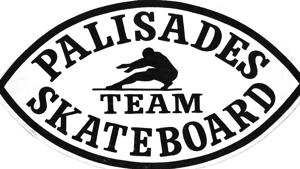
One week later, Laguna Sportswear finally returned my calls and said they’d decided to be our sponsors. Although that would have given us the budget and national scope of Makaha and Hobie, I told them that we’d already committed to Don Burgess. Riding for Burgess kept us at a lower profile than the Makaha and Hobie teams – but it didn’t keep us from being competitive against their skaters in competitions.
Before skateboards appeared, I had a pair of shoe skates and loved weekend racing and figure skating at the roller rink on Santa Monica Pier. At home on Palmera Avenue in the Palisades, I did as other area kids did, taking the wheel assemblies from metal skates and nailing them to the bottom of a 2x4 board. Initially, a vertical 2x4 was nailed to the front to support another 2x4 across the top as a handle. I’d roll down the Palmera sidewalk to Northfield Street. The metal wheels allowed too little control to try rolling down the steeper Northfield.
Then three things happened in quick succession, perhaps within one year around 1962-63. Someone discovered that the vertical piece wasn’t necessary: you could ride without a handle. Next, someone replaced metal wheels with composition wheels from indoor shoe skates. The pavement quickly wore down the indoor wheels, but they provided real traction and opened the door to maneuvers that could mimic surfing. Finally, the 2x4 was replaced by a wider piece of hardwood that came to be shaped like a surfboard.
The first person I saw riding like a surfer was Sandy Morison. He was a couple years older than I was. I saw him doing kick turns up the sidewalk on Tahquitz Place. He was so cool that I wanted to change my name to Sandy. *
Skateboarding’s first wave lasted from about 1963 to 1967, born in the Palisades. Most of the skateboarders were in junior high or elementary school. They were also beginning surfers, and skateboarding moves were naturally linked to surfing. It was even called sidewalk surfing.
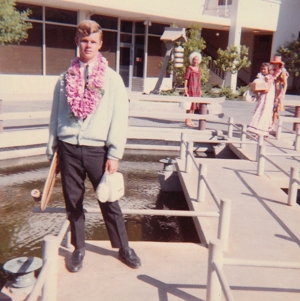 I’ve always thought there were two reasons that the three dominant skateboard teams – Makaha, Hobie, and Palisades – all formed in and around Pacific Palisades. First was the proximity to the beach and surfing. Second was another function of geography: because they’re carved into the sides of the Santa Monica Mountains, most of the school playgrounds in the Palisades and Brentwood have asphalt slopes that surround them. At the corners, two slopes connect in a 90-degree bowl section that provided skateboarders a ride similar to surfing. I’ve always thought there were two reasons that the three dominant skateboard teams – Makaha, Hobie, and Palisades – all formed in and around Pacific Palisades. First was the proximity to the beach and surfing. Second was another function of geography: because they’re carved into the sides of the Santa Monica Mountains, most of the school playgrounds in the Palisades and Brentwood have asphalt slopes that surround them. At the corners, two slopes connect in a 90-degree bowl section that provided skateboarders a ride similar to surfing.
Ten years before the now-famed Z-Boys formed in “Dogtown” (Ocean Park and Venice), launching skateboarding into swimming pools, skateboarding’s first wave of riders was blazing high-speed lines down the huge slopes at Paul Revere Junior High School or riding high and long across the steep walls at Marquez Elementary School. After school one crowded day on the slopes at Palisades Elementary School, I remember the thrill we felt when finding ourselves watched from the sidewalk by the giant Lurch – Ted Cassidy – of TV’s popular The Addams Family.
Skateboarding grew so popular that the school slopes were as crowded as the lineup at Malibu. You had to get there early to have them to yourself. Long before dawn one morning, I skated to Sunset Boulevard and past the high school and “the Center.” At Chautauqua, Dutch Myers was waiting for me. (His family kitchen had recently burned when his brother Dolph heated surfboard wax on the stove.)
Dutch and I skated in the darkness down the centerline of empty Sunset Boulevard – I remember the smell of a skunk near Rustic Canyon – all the way to Paul Revere, then across to San Vicente. As planned, we reached Brentwood Elementary School at first light – only to find its slopes already occupied by two skaters that had gotten there ahead of us!
It grew crowded as we rode the slopes for a couple hours. Finally Dutch and I continued eastward, skating to my grandma’s apartment near Wilshire and 14th, where I knew we could find ice cream and a ride home to the Palisades.
The oldest kid on Palisades Skateboard Team, I was organized enough to lead a skateboard team and land it a sponsor, but not organized enough to produce written records. Team member Peter Burg, now of Rye, CO, posted an impressive history on his blog in 2010. (Peter’s history and Patty Burns’s 2013 Palisadian-Post feature are both reprinted below.) His list of team riders includes himself along with Burke and Shane Murphy, Don Mike and Ricky Burgess, Tim and Terry Keller, Rick Purcell, Chris Picciolo, Tod Elmergreen, Jerry Giancola, Barry Blenkhorn, and Suzie Rowland.
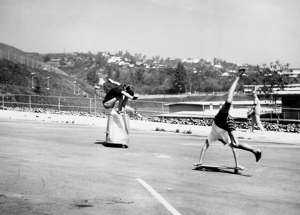
In July, 1966, my press release in the Palisadian-Post began, “Skateboarding – the nation’s youngest and most rapidly growing sport – now represents Pacific Palisades on a team basis, and quite well. Sponsored by Palisadian Don Burgess, the Palisades Skateboard Team won the first annual South Gate Open Contest July 4.” An accompanying photo shows the winner of the 11-year-old and under division, Barry Blenkhorn, doing a headstand on a Palisades Skateboard in the alley behind the Post. Barry later became better known as Barry Williams – Greg in The Brady Bunch.
Don Burgess made a 16mm feature film of the Palisades Skateboard Team in action. I narrated the film for a crowded public showing at Palisades Recreation Center. None of us has seen the film for 45 years. I understand that it’s in the hands of Burgess’s son, Don Michael Burgess, who’s gone from a junior member of the skateboard team to an illustrious career as Academy Award-nominated cinematographer of such films as Forrest Gump, Cast Away, Spider-Man, Flight, and 42. I keep hoping he’ll convert his father’s Palisades Skateboard Team film to digital format and post it to YouTube for the world to see.
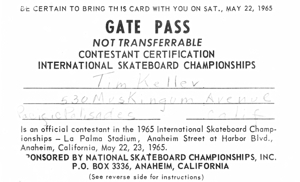 Beyond that, each of us – all now around 60 years old – has our own photographs and ribbons and trophies. My scrapbook includes my competitor’s tags for three events at the International Skateboard Championships, May 22-23, 1965, broadcast by ABC’s Wide World of Sports from Anaheim’s La Palma Stadium. Beyond that, each of us – all now around 60 years old – has our own photographs and ribbons and trophies. My scrapbook includes my competitor’s tags for three events at the International Skateboard Championships, May 22-23, 1965, broadcast by ABC’s Wide World of Sports from Anaheim’s La Palma Stadium.
When the films Dogtown and Z-Boys (2001) and Lords of Dogtown (2005) brought fame to skateboarding’s second wave, I lamented the fact that the young sport’s first wave seemed all but lost to history. A decade later – and a half-century after it all started – I’m gratified to see the story re-emerging and Pacific Palisades resuming its rightful claim as the birthplace of skateboarding.
* * * * * * * * * *
Two photos above:
Right, in color, I landed at Honolulu Airport in August, 1965, holding my camera and my Palisades Skateboard.
During a month devoted largely to surfing with my friend and host, former Palisadian Johnny Mounts, I also gave a skateboarding exhibition at The Outrigger Canoe Club on Diamond Head, where Johnny's mom had gotten me a guest membership and where I saw the famed Duke Kahanamoku, surfers such as Joey Cabell, Fred Hemmings, Paul Strauch, and Butch Van Artsdalen, and Beach Boy Mike Love.
Left, in the Palisades-Malibu Jaycees Skateboard Tournament, at Palisades High School in July, 1966, my trick run included riding a trash can down the hill as my opponent thrust into a handstand. (I did a handstand, too, though I never managed to do it atop the trash can! Peter's story below paints a great picture of how creative we all were, racing to invent new skateboard tricks.)
Below: the only photo I have of me surfing. Will Rogers State Beach, at the foot of Santa Monica Canyon, 1965.
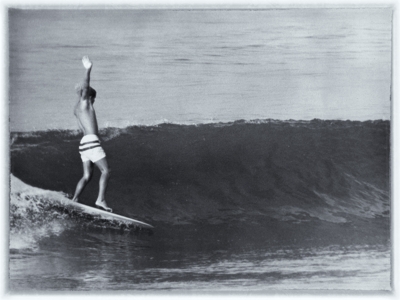
© 2013, 2016 Tim Keller
Updates:
* I never knew Sandy Morison, but after reading this article he clicked the comment link below and left the following note in the TKA Guestbook: "I learned how to kick turn from Paul Resnack and Jamie Budge. Paul was dating my sister and Jamie was his best friend. They were from Santa Monica and they were doing it on metal skates and homemade boards a few years before anyone. Both great surfers." (Through an email exchange, I learned that Sandy never liked his boyhood nickname; he's Alexander Morison.)
* The Post feature garnered generous praise. One reader wrote to the editor, "I am a 30-plus-year subscriber to the Post. I think the "Skateboarding's First Wave" piece on the cover of Lifestyle might be my all-time favorite Post article. I had no clue skateboarding started here. Thank you for publishing such an incredible piece." Lydia Reed added a note about her sons' skateboarding. A year-end feature asked each staff member various questions, including Favorite Story from the Post This Year: Editor-in-Chief Frances Sharpe and Sports Editor Steve Galluzzo each picked "Skateboarding's First Wave." The page you're reading now has been viewed more than 10,000 times by more than 8000 unique readers. (Some are perhaps more unique than others.) It's currently averaging 16 readers per week.
* Don Burgess went through all the old film cans in his possession and found the skateboarding film. He's had 48 minutes of film restored and converted to digital and it looks great. Plans are underway to add new material and create a documentary film with new interviews (filming in the Palisades in late July 2014) plus a new original soundtrack by Peter Burg and narration track by Tim Keller. Creating the documentary will take all of 2014, at least. The film's release should arrive 50 years after the heyday of the Palisades Skateboard Team. Don says, "This will either find some commercial life or be the best home movie ever made." Watch here for updates.
* As we work on the documentary film, we'll add other names to the roster of the Palisades Skateboard Team, beginning with Colleen Boyd, Donna Cash, Scott Blenkhorn, and Kevin Jones. We apologize for missing them above. Memory loss is a terrible thing.
* And others, we've discovered that we've already lost.
R.I.P.
Jerry Giancola, Scott Blenkhorn, and Steve Picciolo.
* December 2016: With help from Marc Loopesko, we've found Shane and Burke Murphy. Shane's a farmer outside of Santa Cruz, CA, and Burke is a carpenter working on fine sailboats on the Mediterranean coast of France. He married a French gal and they have an 18-year-old son. Shane's got him beat with five sons--ranging in age from 47 to one-and-a-half years old. (Dang, Shane!)
We're still searching for Rick Purcell. Please contact Tim.
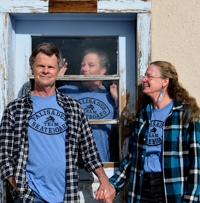
* Reading the Post feature online at home in London, my daughter Darcy Day Keller was inspired to have Palisades Skateboard Team t-shirts made for the extended family. She downloaded the jacket logo from above and surprised everyone with shirts that arrived between Christmas and New Years. Peter Burg visited me and my wife Christina Boyce in Raton for his 60th birthday January 4. We watched the film footage, added to the plans for developing the documentary, and then went outside to model the new t-shirts (right). As I prepare for a "market research" screening to excited students at Raton High School, it occurs to me that, when the documentary is released, there may be a significant market for Palisades Skateboard Team t-shirts and even skateboards. This is getting interesting.
* Two photos of Peter Burg now available and fun to see -- 1965 in Skateboarder magazine at the International Skateboard Championships, and winter 2014 in downtown Raton, New Mexico. Peter has composed and recorded two dozen new surf-guitar instrumental songs for the film soundtrack. They're rockin' fabulous.
July 2014 -- Here's a list of who came for reunion and filming in the Palisades in late July (with current and former name where applicable, and current location):
Don Burgess (Don Mike) -- Pacific Palisades
Ric (Ricky) Burgess -- Pacific Palisades
Peter Burg -- Rye, Colorado
Tim Keller -- Raton, New Mexico
Terry Keller -- Pacific Palisades
Suzanne Levin (Suzie Rowland) -- Solana Beach, CA
Tod (Elmergreen) Burton -- Carlsbad, CA
Donna (Cash) Harris -- San Diego, CA
Colleen (Boyd) Turner -- Cardiff-by-the-Sea, CA
Wendy (Bearer) Bull -- Burns, Oregon
Patty Burns, mother of Danny & Wendy Bearer -- Pacific Palisades
Jack Keller, father of Tim & Terry Keller -- Pacific Palisades
Cris Dawson & Ray Flores, West LA, Hobie/VitaPact, "The History of Freestyle Skateboarding" upcoming website.
Sent regrets:
Tony Picciolo -- Long Beach, CA
Alexander (Sandy) Morison -- SF Bay Area
Barry (Blenkhorn) Williams -- Branson, Missouri
We're also gathering memorabilia (photos, skateboards, jackets, entry forms, newspaper clippings, trophies, ribbons, magazines, etc.) and hope to find more film footage of skateboarding at Paul Revere JHS, Palisades Elementary, and Brentwood Elementary to supplement what we have at Palisades HS and Bellagio, Kenter, and Marquez Elementary Schools.
* July 2014 -- The reunion was an amazing success -- click here!
* November 2014 -- Don's film, now titled Skateboarding's First Wave, will be completed this month and team members have been invited to the premiere screening in Santa Monica. I've seen a recent cut and it's a thrill--a rapid-fire 22 minutes good enough that Don's agent is sending it off to film festivals from Sundance to Berlin.
* December 20, 2014 -- Nine original members of Palisades Skateboard Team joined in Santa Monica with family and friends for the invitation-only premiere screening of Skateboarding's First Wave. Pictured with the movie poster below are, from left, Colleen Boyd Turner, Terry Keller, Wendy Bearer Bull, Tim Keller, Peter Burg, Don Burgess, Suzanne (Suzi Rowland) Levin, and Ric Burgess. Donna Cash Harris got away before the photo, taken by Colleen's daughter, Kim Turner.
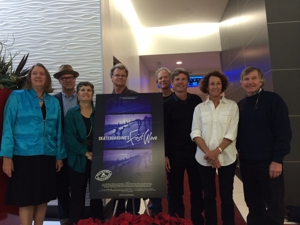
Two Palisades High School screenings are set for June 13, 2015. A publicist is shepherding the film through film festivals, including a showing at TCL (formerly Graumann's) Chinese Theater on Hollywood Boulevard. A DVD for sale will follow in 2016. There's plenty more film, from the 1960s and 2014, to make a separate feature-length movie, if the documentary short attracts the necessary financing for a more ambitious and expensive project. Fingers crossed.
Meantime, Peter Burg is producing a soundtrack album, due out soon. The film includes seven of his tunes, but the album will include all 25 surf guitar instrumentals that he wrote, performed, and recorded for the film.
September 27, 2015 -- Tim and Peter accepted the Silver Trindie Award on Don's behalf at the 4th Annual Trinidad Independent Film Festival. (They also enjoyed the screening, the Q&A, and the free drinks and steak dinners--this film festival business ain't half bad.)
Summer 2016 -- After three enthusiastically received screenings at New York City's Tribeca Film Festival in April, Skateboarding's First Wave is spending the summer (through September) on United Airlines' in-flight entertainment menu, part of a program called Tribeca Shorts.
Carhartt Work in Progress has published its 208-page A Skateboarding Annual 2 coffee table book that includes a full-page, two-photo sequence of Tim "hippy jumping" over a bench in 1965, with screen-grab images provided by Don Burgess from the Skateboarding's First Wave. CarharttWIP threw book release parties in Lille, France, May 27; Copenhagen, Denmark, June 6; and New York City June 23. The book is available online for $25 as long as the 3500 copies last.
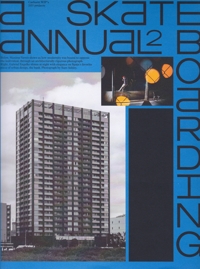 
November 2016 -- Two big news items: Skateboarding's First Wave is coming to Showtime, and Peter Burg's soundtrack album has just been released.
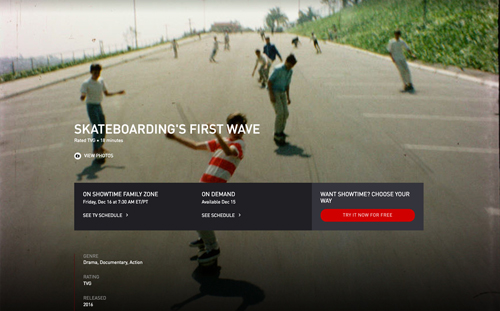
Beginning December 16, 2016, Skateboarding's First Wave will be available worldwide via Showtime and Video on Demand. This version is shortened by four minutes, from 22 minutes to 18 minutes: The additional cost of the rights to all the old TV show clips for commercial release was prohibitive so they had to be cut. (There are a lot of DVDs out there with the full-length film: Try to see that if you can. Losing the TV clips is going to hurt.)
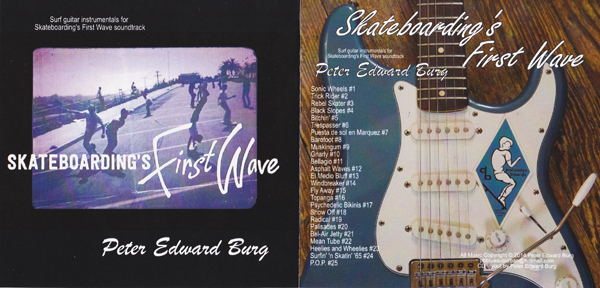
Peter Burg has finally released a CD album of all 25 of the surf guitar instrumentals that he wrote and produced for Skateboarding's First Wave. Seven of the tunes made it into the film, but here you can get the whole enchilada, new surf-skateboard tunes with titles like Palisades, Bellagio, Topanga, Muskingum, P.O.P., El Medio Bluff, Bel Air Jetty, Barefoot, Trespasser, Asphalt Waves, and Psychedelic Bikinis!
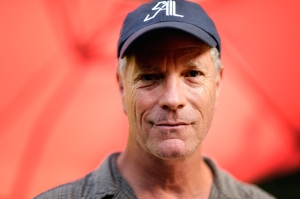
Click the CD cover above to see it enlarged, and click here to read Peter's liner notes inside, complete with ordering instructions. CDs are $15 by mail order, with additional copies in the same mailing $10 each (PO Box 304, Rye, CO 81069). Tim Keller's portrait of Peter was taken in Rustic Canyon during the 2014 filming of Skateboarding's First Wave, when Peter and Tim rode Amtrak's Southwest Chief from New Mexico to LA then took a bus to the west side; click the photo to see big Peter. Want even more? Scroll down to read Peter's 2010 "Beach, Surfing, and Skateboards: Growing up skateboarding and surfing in Pacific Palisades in the 1960s," which partially inspired Tim's 2013 Palisadian-Post feature.
Here's a newly discovered gem, seven members of Palisades Skateboard Team on the parking ramp at Palisades High School in 1965 or probably 1966. (Click to enlarge.)
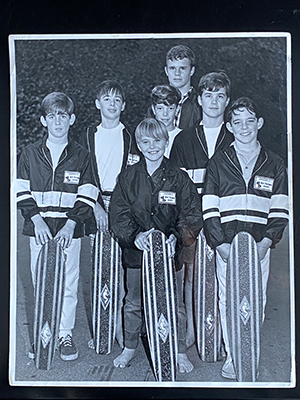
Don Burgess found this photo in April 2020 as he was doing deep spring cleaning during the Covid-19 coronavirus pandemic shelter-in-place orders. From left are Burke Murphy, unknown, Don Burgess, Peter Burg, Tim Keller, Terry Keller, and Barry Blenkhorn (later Williams). None of us know the unidentified skater second from left, which is weird since he's wearing a PST jacket. Only Burke and Barry are wearing shoes; the other five are skating barefoot, which is the way we did it back then. No helmets, no pads, no shoes. Tough feet, tough kids back then.
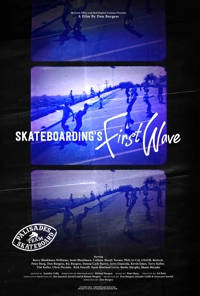
The film "Skateboarding's First Wave" now has its own website complete with cast and crew biographies, news, links, and a 97-second preview of the film. Click here!
The film has its own Facebook page, too.
Read Tim's original November 2013 Palisadian-Post feature -- click here.
Read the Palisadian-Post feature on the 2014 PST reunion -- click here.
Read Tim's narrative of the 2014 PST reunion & filming -- click here.
Read Palisadian-Post feature on the December 2014 film premiere -- here.
Read Greenhorn Valley View feature from Rye, Colorado, February 5, 2015:
"Peter Burg Featured in Skateboarding Documentary"
Read Colleen Boyd Turner's wonderful 2015 Huffington Post feature
"Back to the '60s in Our 60s"
Read a front page profile of Tim and Peter for their appearance at "TridieFest"--Colorado's Trinidad Independent Film Festival, September 2015
Read Braden Walker's great Palisades News feature,
"The Palisades: Birthplace of Skateboarding," September 2018
Here's the roster we've compiled for the end of the film:
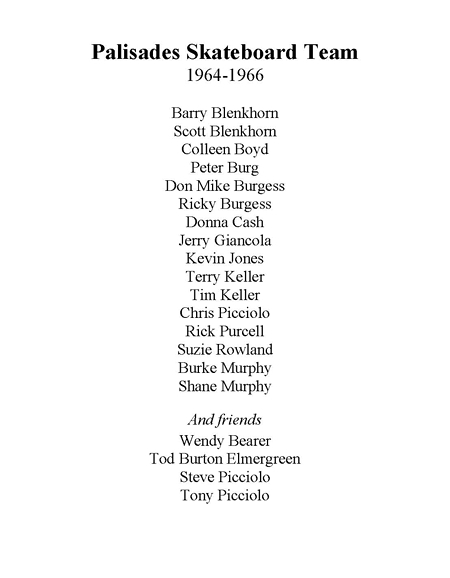
Leave a comment?
Beach, Surfing, and Skateboards
Growing up skateboarding and surfing in Pacific Palisades in the 1960s.
by Peter Burg
(Copy editing by Tim Keller)
Originally published July, 2010 -- click here.
Click Peter's surfing photo there to get seven photo illustrations.
An additional history by Patty Burns follows.
I grew up in Pacific Palisades in Southern California overlooking the Santa Monica Bay with a view of Palos Verdes and Santa Catalina Island. The beaches had a profound influence and wove into my life. The overcast mornings, sound of waves, smell of saltwater air, sunsets on the bluffs, and sunny beach fashions were everywhere.
My parents bought a home on Muskingum Avenue in 1952. At that time you could see the ocean from our living room bay window before the eucalyptus trees grew. The Burgs spent many afternoons on the beaches along the coast highway. My mother and father would schlep us kids to hang out with our first cousins the Smiths, Mary Lou and Jimmy and their kids, down at the Deauville Club. The club was located at the base of what is now the Santa Monica Ramp. There was a whole contingent of families that would get together and play volleyball in the sand. This was in the late fifties and I was just old enough to walk around and burn my tender feet on the hot sand. Probably this is where I got my first taste of saltwater and the pain of sunburn. We would arrive in my parents late forties era "woody." My sister Melissa, Laura, Ricky, or Patty and I would mingle and dig in the sand with the Smith kids, Andrew, St. John, Maura, Paul, Beaver or Georgie. Volleyball was popular at the time and was also played at State Beach (Will Rogers State Beach) located at the base of Chautauqua Blvd. at Pacific Coast Highway 1. This area and most of the Santa Monica Bay was a hot bed of beach volleyball and also known for good surfing since the 1920s.
In 1959, my sister Pattie worked in a ice cream parlor next to the Standard gas station across from Mayfair Market on Sunset Blvd in Pacific Palisades. She was a student at Santa Monica Junior College on Pico Blvd. During this period she met Con Colburn. Con would come in all straggly, wet, and sandy from surfing and try to talk her out of an ice cream cone. She gave in most of the time and they became great friends. Their friendship lasted four or five years and during that period she helped with bookwork and painting signs for his fledgling surfboard business, Con Surfboards. She also would accompany him when he would pick up blanks from the Hobie shop, because at that time Con was not making his own blanks. Con's shop in 1959 was located on Olympic Blvd. in Santa Monica. As Pat was my surrogate mother, she would take me along on her visits so I spent time at the shop as well. The smell of resin and fiberglass and the sound of Con sanding and shaping the boards is still with me. On many occasions Pat and Con would go to surf movies at the Santa Monica Auditorium. These were rudimentary 8- and 16-millimeter home movie surf films that were projected on a screen and usually the guy who shot it would narrate over a public address system.
My other sister Laura was asked out numerous times by Miki Dora. She refers to him as the Bad Ass Blaster. She says of her Malibu days in the summer of 1962 that Miki would approach her on the beach saying, "Hey pretty baby, let's go out." Her high school friend, Mandy Pryor, had crushes on the Aaberg brothers, Steve and Denny. Once, Mandy dove off the Malibu pier just to impress them. Laura said the more intellectual surfers played chess on the beach while the others, like Lance Carson and Johnny Fain, duked it out on the waves. Needless to say, we had some of the top surfers walking up our driveway and knocking on the front door. Ah, the lure of young girls.
It was sometime during 1964 that I constructed my first skateboard. Cub Scouts was the latest activity that my parents had me involved in and this particular day my mother delivered me to the weekly gathering which was at Philip Cleary's home on Alcima in the Pacific Palisades. Phillip and I were grammar school mates and his mother had the troop set up in the garage. During these meetings we made all sorts of stuff like key chains glued to cracked marbles, gifts, and whatnots. One day the boys had a box filled with old garage-sale steel roller-skates and boards from Philip's father's lumberyard (Palisades Lumber and Materials). In no time, we disassembled the skates by removing the center wing nuts with pliers. The next step was to flatten the heel and toe guards with a hammer so that the skate would lie even on the boards. It was a wonder that no fingers were smashed with all of the racket we made with those hammers. Next was to attach the skates to the boards. We used flathead nails, hammered in and bent over. It was trial-and-error to find the ideal location for each skate, front and back; after all, we were treading on virgin territory. Finally, the first to flip his board over and ride was sorely surprised. Those that had nails sticking through the top had to bend them over or risk bloody feet and those that nailed the skate on crooked would fly helter-skelter off into the bushes. It was pretty comical to watch a bunch of hyper kids in Cub Scout uniforms careen down the sidewalk. These skateboards with steel wheels made the sound of a roaring jet going by. They also made a funny white trail as the wheels crushed the concrete pavement.
Commercial skateboards did not exist for me. At ten and eleven I was fairly self reliant and continued to make my own with upgraded wheels and board shapes as others did. The kids in the neighborhood were wise to skates for most of us participated in the Friday night roller skating at Palisades Park, where you could rent skates with wooden wheels, skate inside the gym to your favorite rock 'n roll music on a record player that spun 45's, and maybe play a game of dodge ball afterwards.
Surf music was prominent on the airwaves and we were hep to it. AM stations such as KFWB and KRLA played a mix of Duane Eddy, Dick Dale and the Deltones, The Ventures, The Beach Boys, The Surfaris and numerous other surf bands on a regular rotation. I had a Surfaris album with yellow trim and a picture of surfers at the Malibu wall which I thought was totally bitchin'. The big fender reverb sound was everywhere.
Most of the kids that were skateboarding in the Palisades had an intimate relationship with the surf. We grew up on the beach either learning to body surf, skim board, raft, belly board or surf. We were all good swimmers too. My sister Laura loved to swim out beyond the big sets and then call me to follow. It was pretty gnarly to swim out and dive under six and seven foot waves. I had to grab on to the sand under the water and then push off the bottom after the wave broke over me. I learned fast how to take a wave, get tubed, duck under the wave just when it broke, and pop out on the other side. Back then we didn't use fins. At Bel-Air beach's lifeguard tower #5, where we hung out most of the time, the ocean wasn't that deep so we could still bob off the bottom on big wave days.
Bay Street, State Beach, Sunset Beach, Topanga, Malibu, Zuma, and Trancas were all familiar local spots. But, in fact, in the early sixties most of the beach breaks were excellent for surfing, along with many of the jetties that dotted the Santa Monica Bay. Decent left and right breaks were common. I was a goofy foot so I preferred left breaks. In the mid-seventies, severe storms swept through the bay and changed the wave-breaking profile. It seemed all that was left were shore breaks.
Along with skateboarding, in 1964 I was also playing little league baseball on the Panthers team. More and more kids were skateboarding and congregating at the massive inclined parking lot at Palisades High School, known simply as "Pali." It was fairly loose-knit group, mostly crazy youths hauling ass down the parking lot then climbing back up along the wire mesh that was put down to hold the ivy and bank from sliding; then we'd haul ass down again. At that time bikes and skateboards were our main mode of transportation. (My bike was the ever-popular Schwinn Sting Ray, purple with a sparkle banana seat with semi sissy bar, butterfly handlebars, and a slick for the back tire.) Friends and strangers were beginning to show up regularly at the top entrance of Pali's parking lot. As it goes with kids, boredom begets friendly competition. Going down the incline became monotonous so we went down in new ways. Instead of standing, we sat on the board, laid on it, stood on trash cans—anything we could think of and get good at it. As our competitive natures grew, so did the more outlandish tricks. Kids began imitating surfers with maneuvers such as the "Paul Strauch five," walking the nose, hanging five, hang ten, and leaping pirouettes. As tricks progressed, the skateboarders developed their own terms like kick turns, curb jumping (both up and down curbs), and kick outs. Pretending you were surfing was standard practice. We knew how to be stylish from watching surfers like Miki Dora. Accidents turned into tricks, like having the back wheels slide out when bearing down on a turn. When kids finished zooming down the incline, they would kick out into the ivy but sometimes they would flip their boards up and catch them and that would turn into how many flips could you do before you caught the board. Like anything kids did, showing off was always in the mix. Soon people were there just to watch and take pictures. Tricks got more inventive—kick-outs had spins added, kick turns turned into the frog walk or a 360, walking the nose turned into nose wheelies then into heelies. The combinations simply multiplied.
Next in progression was to set up an exhibition or contest. Teams were talked about and teams began. Several of us, Terry Keller, Burke Murphy, Chris Picciolo and Tim Keller formed a team. Tim became our manager and arranged match contests between us and other teams to take place at the Pali parking lot, one-on-one runs down the horseshoe incline. Judges would score the runs with the best overall-scoring team winning the contest. Tim had been on another team called Sunset Skateboarders and he enjoyed taking on the duties of managing our team.
Pali was not the only spot where skateboarding took place. Any and all asphalt-paved school playground areas with sloped sides were fair game because they were built into hillsides, producing a slope much like a wave in the ocean. The more familiar schools were Marquez Elementary, Palisades Elementary, Paul Revere Jr. High, Bellagio Elementary, Brentwood Elementary, as well as the parking lot in front of Palisades Medical Center. At the height of what I'd call the first wave of skateboarding there were numerous newspaper articles depicting kids as trespassing vandals. There would be photos of kids climbing school fences and squeezing through locked gates of school property. When has that ever happened before? Kids wanting to get into school instead of wanting to get out! The bad press that skateboarding received at the onset, in the mid-sixties, helped to perpetuate a rebellious image that carried on into the seventies. We skateboarded everywhere, taking our boards whereever we went. I remember skateboarding along the old boardwalk from Santa Monica Pier all along Venice down to Pacific Ocean Park ("P.O.P."), hanging on to the trolley for a free tow.
The prevalent consciousness of the day was that skateboarding was a fad that would fade. Little did the public know that skateboarding would someday become a commercial rage and climb to the esteem of an Olympic sport.
Around this time the YMCA was offering a program called "Surf Caravan." This program consisted of several "Y" buses that transported a slew of kids, a few adult chaperones, some YMCA officials, and a bunch of surfboards down to Tijuana and Ensenada, Mexico. The plan was to camp on a fabulous expanse of beach on the Ensenada coastline and let the kids surf to their hearts' content for about two weeks. I went along, as did several of my friends. It was great. I was using a Bing board at the time. There were super beach breaks, the water was warm, and we were even turned loose in Tijuana for a day to learn the art of bartering.
The Palisades Skateboard Team got started in 1965. Several members were actively pursuing a sponsor. I approached a longtime family friend, Don Burgess. He was the owner of Don Burgess Pools and lived on El Medio in the Palisades. Don showed interest and said he would get back to me. On another front, Tim Keller had approached Laguna Sportswear and they also showed interest. We may have been impatient and perhaps should have lined up three or four sponsors to choose from, but as it turned out we decided to go with Don Burgess Pools as our sponsor. Shortly after accepting Don Burgess Pools as our sponsor, Tim turned down the offer from Laguna Sportswear, who would have probably boosted us to the sponsorship and visibility level of other high profile teams such as Hobie and Makaha. But a commitment was a commitment and so now we had an official team.
We got down to business creating a logo and team emblem. Tim was the eldest of the team members and thus the de facto manager and organizer. He spoke with his father, Jack Keller, who sketched out a skateboarder in silhouette doing the "Paul Strauch" maneuver on a skateboard. This was used for our team patch, applied to the back of a black nylon windbreaker with broad white horizontal competition stripe. Tim posed for the patch figure while his father drew it. A patch using the Don Burgess Pool logo was created for the left front side of the jacket to indicate the team's sponsor.
The sponsor was responsible for providing team members with supplies of skateboards, wheels, bearings, team jackets, and transportation to contests, entry fees, and so on. Don was actively involved with the team. Out of his house he began manufacturing custom boards that the team members would test ride and report back. By this time a new type of clay wheel had been developed. Don was inventive and used ideas from pool design, introducing them to skateboards. He developed a resin mixed with sand for a non-slip grip surface around pools, then applied it to skateboards in competition stripes in various colors. The board shape was solidified and Palisades Boards began production. Not only did team members receive new boards but the boards were sold at local stores including Palisades Hobby Shop.
The team started to grow in two areas. First was new membership. The roister included Peter Burg, Barry Blenkhorn, Burke Murphy, Shane Murphy, Tim Keller, Terry Keller, Don Mike Burgess, Ricky Burgess, Rick Percell, Chris Picciolo, Todd Elmergreen, Jerry Giancola, and Susie Rowland. At the time, Susie was only one of a handful of talented girl skateboarders. (Others would be Colleen Boyd and Wendy Bearer, who was the sister of Danny Bearer, both on the Hobie Team. Wendy appeared on the Ed Sullivan Show skateboarding around in a circle to some current song of this period.) Most of the team members surfed on a regular basis as well.
The other area was the development of new tricks such as handstands on a moving skateboard. I began experimenting by holding the board on the pavement, moving slowly, then kicking up into a handstand. This evolved into going down into a frog stand while skating along, pressing into a full handstand, coming back down on the board and again standing upright, all while the skateboard was flying along. 360s turned into 720s, then 1080s. Other new tricks included one-footed heelies and wheelies, headstand into handstand, and of course the stall, where you lean the board back on its tail end and drag along the ground, used as a brake to slow down. Jumping over school benches turned into jumping over a bar at a measured height. All of these tricks were being invented, practiced, and perfected.
The world of skateboarding exploded and teams popped up everywhere. The International Skateboard Championships held at the La Palma Stadium in Anaheim, May 22-23, 1965, brought skateboarding into living rooms throughout the world. There were 280 boys and girls that showed up from Mexico City, Dallas, Phoenix, Berkeley, and Southern California to compete in this rally sponsored by the Vita-Pak Super Surfer Skateboard team. ABC's Wide World of Sports televised the competition and included my run in the flatland slalom. Our team finished third to Hobie and Makaha. The Hobie team's John Freis and Torger Johnson won first and second overall. Torger was by far the most radical and fluid skateboarder in the contest. In the 11 and under age bracket, Don Mike Burgess, eight years old, was third overall, placing third in figure-eights and the flatland slalom. I was fourth in flatland slalom and fourth in trick-riding. We both received finalist medals.
More contests followed: the South Gate Open Contest, July 4, 1965; Palisades-Malibu Jaycees Skateboard Tournament, 1966; and a contest between Brentwood's Ventures and Palisades Skateboard Team, 1966. So many friends were skateboarding that it's hard to remember them all but the Stevie and Davy Hilton, George Trafton, Jay Henderson, Kevin Jones, Bob Janis, Scott Kelso, Pat Hunt, Scott Archer, and Donna Cash come to mind.
Our sponsor, Don Burgess, was an avid 16mm moviemaker. He shot numerous films of the team at various contests. One shows me during a group exhibition going down the Pali incline where I did a handstand, veered off into the ivy, and crashed into a sprinkler head. I received a severe cut on my hand and had to be taken to the hospital to get several stitches. Many of these films may still be available through Don Mike Burgess, Academy Award-nominated cinematographer (Forrest Gump, etc.).
I spent many days during those summers walking to and from Bel-Air beach. There was a trail through the private club down the ice-plant hill that dropped onto PCH. There you had to cross the highway at your own risk. We had a great group of kids in bikinis and jams that hung around lifeguard tower #5. Frank Barnes was the lifeguard and he was the coolest. Before becoming lifeguard, Frank played water polo for San Jose State. On many mornings I would meet him at tower #5 and together we would jog up and down the shoreline. We all literally looked up to him: at 6'4" he was an impressive dude. One day I dragged my sister Laura down, introduced her to Frank and, as it happened, they fell in love and later were married.
Speaking of sisters, another sister of mine, Melissa, just a year older, was spending time with Torger Johnson. She was in the seventh or eighth grade at Corpus Christi school and Torger was in the ninth grade at Paul Revere Jr. High. They were sweet on each other and it was cool to have Mr. Skateboarder himself saunter up to the front door for a visit. By the way, Torger was a phenomenal surfer, too.
Jumping on the bandwagon in July of 1967, the Hormel company planned to shoot a television commercial with skateboarders. Don Burgess was contacted and auditions were held; four members of our team were chosen. Barry Blenkhorn, Don Mike Burgess, his younger brother Ricky, and I were to be in The Not-So-Hot Hot Dog commercial. I was chosen over teammate Terry Keller on the basis of height. There was a photo shoot for stills that ended up plastered on the Hormel trucks that drove around various cities. The TV commercial ran for a year and we were compensated handsomely; we all collected residuals as well. The Hormel gig put us in the realm of professional skateboarders. It was one of the earliest commercials using skateboarders.
As the summer wore on, I finished playing baseball with the Pirates (Pacific Palisades Boys Baseball Association) and spending time surfing at State Beach. Some time around this period I bought a new Hobie 8' 2" clear-coat board. It was beautiful. I also purchased a plastic nose guard to fend off dings, along with an O'Neil wetsuit. The new smaller boards were just arriving. Our group of young surfers spent the days learning to play penny-ante poker, smoking cigarettes, and trying to impress girls. I was surfing with Irv Hansen and spending time with Terry Macris, a poet /surfer. He was Frank Barnes's roommate at a house at First & California Street in Santa Monica. Frank introduced us. Terry's parents owned the house. Terry was much older at 24, so I was more like a mascot that tagged along. He took me surfing many times in his totally bitchin' '67 Chevy Impala. We would get up early for donuts and just cruise the southern beaches—Venice, Playa del Rey, El Segundo (El Stinko), and as far south as San Clemente. Once, while surfing in San Clemente, I stepped on a sea urchin and had to pull purple spikes from my heel. State Beach had lots of great surfers hanging out—Da Cat Miki Dora, Johnny Sugarman, and Corky Carroll. You could always catch someone shredding.
As with everything, change is inevitable. During the later part of the 60s, I began a lifelong involvement with rock 'n roll. I found a new passion, the guitar.
© 2010, 2013 Peter Burg
Leave a comment?
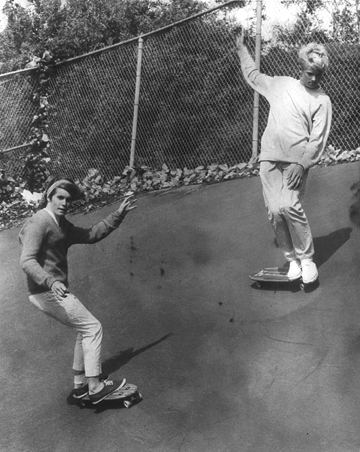
The Bearers:
Skateboarding Pioneers of the Palisades
by Patty Burns
Published August 22, 2013, by the Palisadian-Post. Reprinted with permission.
Editor’s note: Longtime Pacific Palisades resident Patty Burns has written the following article for the Palisadian-Post. Her children, Danny and Wendy Bearer (above), were skateboarding pioneers.
The sport/art of skateboarding was born in the mid-1960’s. A lot of us had nailed our old rollerskates to the bottom of a 2×4 and skated on our sidewalks, but the new wave was conceived by surfers when the surf was small, as a way to exercise on land and have a lot of fun doing it.
In 1963, Larry Stevenson formed a team called Makaha to compete in the new evolving sport. The wheels were such that sidewalk surfers could do more tricks than ever and gain more comfort and speed. The first members of this team were Danny and Wendy Bearer, John Freis, George Trafton, Torger Johnson, Dave and Steve Hilton and Greg Carroll. Soon, contests were held all over California and other teams formed. Don Burgess and son Don Mike made up a competitive team with Peter Berg, Barry Blenkhorn, the Keller brothers and Chris and Steve Piccilo – all Pacific Palisades kids – called the Palisades Skate Team.
Hobie Alter picked up on the new sport and the Makaha team all joined Hobie Super Surfer, adding Colleen Boyd, Suzie Rowland and Woody Woodward.
The first national skateboard championship was held in Anaheim at La Palma Stadium in 1965 and was won by the Hobie Super Surfer team. It was carried on Wide World of Sport (ABC) and Dan and Wendy Bearer were both interviewed. A tournament was held at Santa Monica Civic Auditorium the next year and Wendy was the first competitor to receive three “10s” in a contest. Her outstanding trick was to jump from her moving board over a three-foot-high jump and land back on her board.
The Hobie Team toured the U.S. with the boys only (as there was no girl chaperone), giving shows in stores across the country and down the East Coast. They were outfitted by Hobie in sport coats and slacks to travel in, and striped blue and white shirts and shorts and of course Vans shoes, which have become a part of skating.
Since all of these skaters were surfers, they named the various schools after hot surf spots: Brentwood School was Malibu, Paul Revere was Sunset Beach, Hawaii, Marquez was Bonzai Pipeline and Bellagio was Waimea Bay. They skated on the paved but uneven slopes at all these schools every weekend. Unfortunately, there were many broken bones in those days – no one wore pads!
As skating so closely resembled surfing (the moves were similar), in addition to kick turns, 360s, 180s and wheelies (now called manuals), they did a lot of “walking” moves to get to the nose of the board, and did a nose wheelie (hanging 10 on a surf board).
“We invented moves as we went along,” says Wendy. “We were pioneers and had only each other to learn from.”
Wendy and Dan were also on the Hobie Surf Team and members of the Malibu Surf Association. Dan was ranked 17th in the country as a 17-year-old and Wendy was one of the few women surfing in her day. They both won the first L.A. City Championship at Sunset Beach in 1968.
“Skating is fun,” says Wendy, “but surfing is the ultimate thrill sport – you are moving on moving water and there is no other sensation like it. Heaven will be endless waves and warm water.”
Some other surfer girls in the Palisades were Suzie Rowland, Nancy Emerson and Colleen Boyd.
Since the advances in technology, the whole skateboard game has changed. In the ‘70s, Dogtown and Z Boyz took skating to new levels, introducing maneuvers and tricks never dreamed possible. Tony Hawk and gang were all amazing, but the ‘60s group were the true pioneers of skating.
Five years ago, the International Skateboard Hall of Fame was formed to honor skaters who have had exceptional careers as well as those whose body of work has affected development of equipment as well as competition.
Danny Bearer was inducted into the Skateboarding Hall of Fame in 2012, while Wendy Bearer Bull was inducted this year.
There is a skateboard museum, Skatelab, in Simi Valley which features five decades of memorabilia including 5,000 vintage boards. It offers free admission and safety demonstrations and clinics teaching techniques and showcasing history.
So all you young skaters: know there is a lot of history about your passion, but please be respectful of your sport and of all of the people and places that you affect around town.
©2013 Patty Burns
Leave a comment?
|